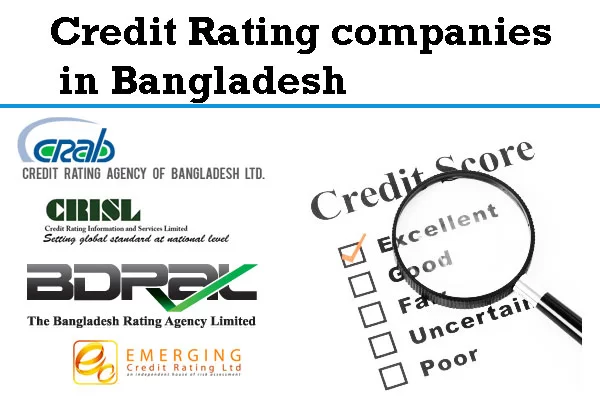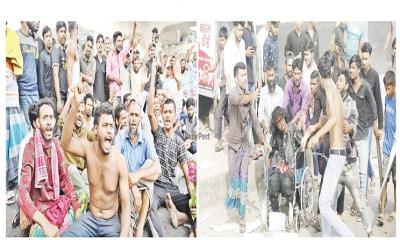Riskier banks also got the highest credit rating
These ratings are not reliable: Ahsan Mansoor
They are supposed to work independently: Mehmud Hossain
Central banks are not their regulators: spokesperson
After the disclosure of information on 38 extremely weak and weak banks in the country's banking sector, questions have arisen about the ratings of credit rating agencies. In Bangladesh Bank's Health Index and Heat Map report, the bank which has been identified as red zone or extremely weak, has also got the highest credit rating. It has been alleged that rating agencies give credit ratings to weak banks to show their health.
In this regard, several bankers said the rating agencies are supposed to look at various factors including default loans, capital situation, profit situation, liquidity situation, loan-to-deposit ratio, management efficiency, management and market risk of a bank. But that's not how the rating works. Now all that is happening is fake rating. They are being given credit in exchange of money. The correct picture of the banks is not coming out in their rating.
There are currently 8 credit rating agencies in the country. These are Credit Rating Information and Services Limited (CRISL), Credit Rating Agency of Bangladesh (CRAB), Emerging Credit Rating Limited (ECRL), National Credit Rating Limited (NCRL), Arjus Credit Rating Services Limited, Alpha Credit Rating Limited, WASO Credit Rating Company and the Bangladesh Rating Agency Limited.
On the other hand, there have been allegations of pressure on the rating agencies to get better ratings or credit ratings through various tactics. The Association of Credit Rating Agencies in Bangladesh (ACRAB), an organization of credit rating agencies, officially informed the matter in a meeting held with the central bank last year. It is said that many banks are interfering with credit rating agencies to give higher ratings. Then on April 2 of last year, in the bankers' meeting held at Bangladesh Bank with the MDs of all banks, it was warned that if this kind of trend is not prevented, the risk-based asset accounting process of the bank will be disrupted.
According to Bangladesh Bank's recently published Health Index and Heat Map report, AB Bank is among the 9 banks in red zone or very bad condition. But AB Bank, which is in the red zone, has got the highest credit rating or '1' rating.
Mehmud Hossain, the former managing director of National Bank, said the relevant rating agencies can tell how the discrepancy happened and on what basis they made such a rating.
Besides, according to the report of Bangladesh Bank, there are 26 more banks in the yellow zone. Health Index and Heat Map reports have identified them as vulnerable. But among these weak banks, most of the banks have got the highest credit rating. Among them are IFIC Bank, Meghna Bank, Social Islami Bank, Islami Bank Bangladesh, One Bank, United Commercial Bank, Al-Arafah Islami Bank, Standard Bank, Mercantile Bank, Mutual Trust Bank, Exim Bank, Dutch-Bangla Bank, Premier Bank, Madhumati Bank, Uttara Bank and Pubali Bank, City Bank, BRAC Bank, Dhaka Bank and South East Bank have got the highest credit rating or '1' rating.
Besides, NRB Bank, Union Bank, NRBC Bank, Global Islami Bank, Trust Bank and South Bangla Agriculture and Commerce Bank have got second credit rating or '2' rating.
Majbaul Haque, Executive Director and Spokesperson of the Central Bank, said rating agencies do credit ratings based on the financial statements of the banks. And the central bank is not their regulator. BSEC has given them permission. If there is any complaint, it should be addressed to them.
Those concerned said due to various laxities including rescheduling, non-payment due to Corona and global situation, the real picture of defaulted loans is not coming forward in recent years. At the end of last December, banks defaulted on paper at 8.16 percent. In the light of the conditions of the IMF, the report published has identified 3 lakh 78 thousand crore or 25.58 percent of the total debt as distressed. At the end of 2022, 11 banks had less than 10 percent capital. 5 more banks were below 12 and a half percent. 16 banks were below 12 and a half to 15 percent. 14 banks were between 15 and 20 percent and 15 bankers' capital was above 20 percent.
In response to a question, he said there are allegations of increasing the loan standard by putting pressure on the agencies. The governor also warned the MDs about this. MDs work in banks. They are under a board. But the rating agencies do not work under any board. They are supposed to work independently. The central bank should also ask them for answers.
According to the analysis of the data and the report of Bangladesh Bank, the red zone or very bad condition state-owned Janata Bank, Agrani Bank, Rupali Bank and the private sector National Bank have got the second quality credit rating or '2' rating. Central Bank has dissolved the board of directors of the private bank ‘National Bank’ due to record losses, massive interference in management. Still the bank is rated '2'. Bankers have raised questions about this.
Apart from this, Padma Bank, Bangladesh Commerce Bank and National Bank of Pakistan, which are in the red zone, have got the third quality credit rating or '3' rating.
Besides, according to the report of Bangladesh Bank, 3 commercial banks named Bangladesh Development Bank, Sonali Bank and First Security Islami Bank fall in the yellow zone, but the positions of the banks are close to the red zone. Even though the banks are in very bad condition, they are also given a second credit rating or '2' rating.
Talking about these issues, Ahsan H. Mansoor, Director of Policy Research Institute, said credit rating agencies of our country are not absolutely reliable. They are not like Moody's. They have no quality. All ratings can be bought with money.
In response to a question, he said rating agencies need to be rated again. They are not reliable. Central banks should rate them. This economist also thinks that Bangladesh Bank has responsibility in this case. He said Bangladesh Bank must have taken responsibility. A rating agency will make the bad as good and the good as bad, should it be like that way? It is the central bank's responsibility to see these things properly and sincerely.
ZH






